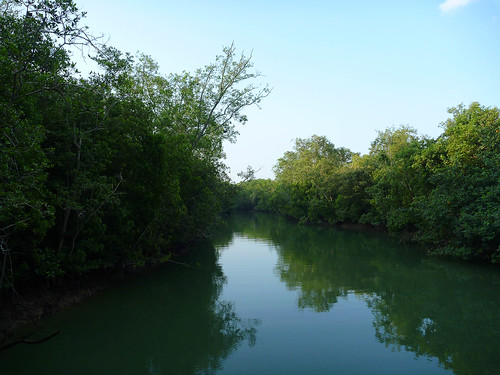
On a hot and sunny afternoon, I decided to drop by the Pasir Ris mangroves, as a show of support for the Mangrove Action Squad, who have been conducting guided tours on the boardwalk for the June holidays.
I've led similar guided walks here in the past together with fellow guides from the Naked Hermit Crabs, although this time around, I chose to participate as a visitor. I find it useful to sometimes keep quiet and listen; every guide has some interesting stories and information to share, and by tagging along at times, I hope to be able to incorporate some of this knowledge into my own guiding sessions. This is how nature guides can learn from one another, building up a repertoire of content and skills that can translate into an enhanced experience for the visitors.

I had the pleasure of having Oi Yee as a guide. Oi Yee is a veteran volunteer with the Raffles Museum of Biodiversity Research (RMBR), and I've also followed her on a Sungei Buloh Anniversary Walk. She certainly has a wealth of information, especially on plants, which is a group that many nature guides tend to overlook.
We started off the walk with a sighting of a pair of red junglefowl (Gallus gallus).
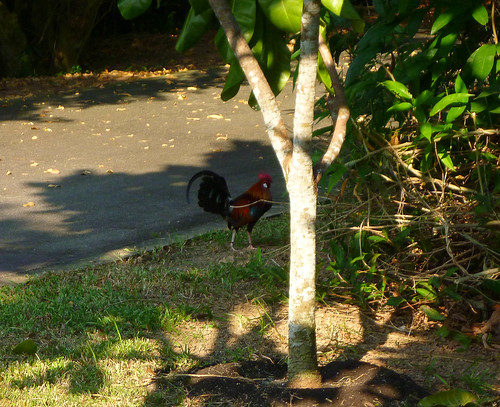
The rooster was quite shy, and the moment he realised that there was a group of people walking in his direction, he retreated into the bushes.
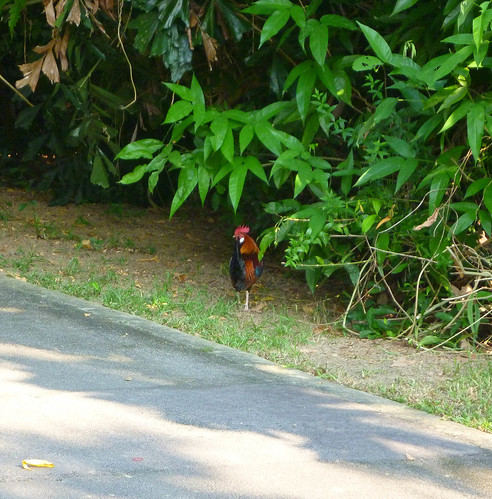
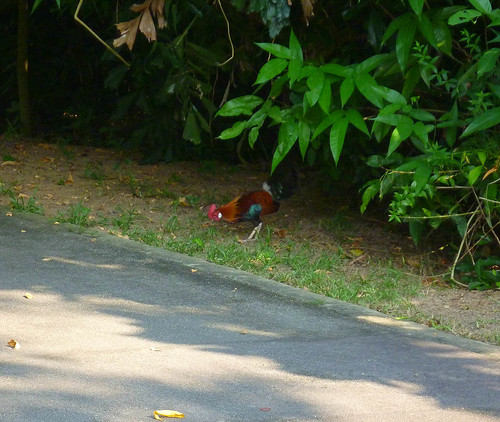

The hen was still quite nonplussed by all the attention, but eventually went over to join her mate, where they could have more privacy while foraging.

This is what I meant by learning from fellow guides. Oi Yee pointed out the clump of tiger orchid (Grammatophyllum speciosum), which is the world's largest orchid species. Like most of our native orchids, the tiger orchid was sadly considered locally extinct due to habitat loss. Since then, however, this species has been reintroduced to many of our parks and nature areas, and even on Orchard Road. Tiger orchids are usually epiphytes, but can also be found growing on rocks, or planted in well-drained soil.
Thanks to Oi Yee, I'll be keeping an eye out in future the next time I pass by this stand of tiger orchids. Hope to see them in full bloom!
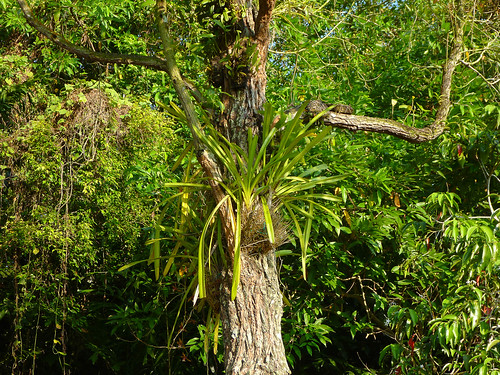
Almost immediately after that, we turned around and she noted that the Finlayson's cymbidium (Cymbidium finlaysonianum) was blooming. This is another native orchid species that grows as an epiphyte. Critically Endangered here, it is one of several orchid species that are the focus of propagation and reintroduction efforts.
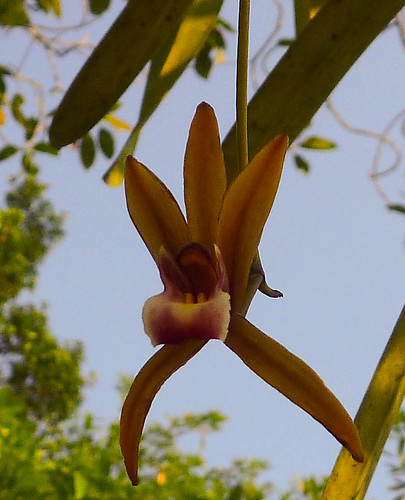
Here's the flower of the Finlayson's cymbidium.
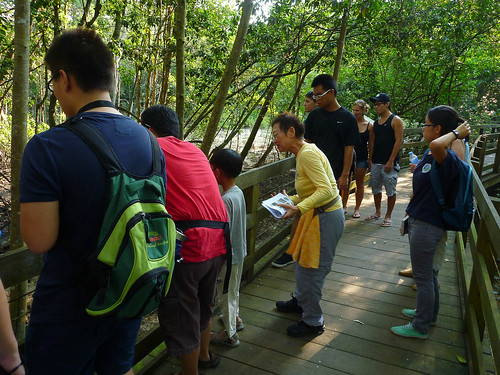
We entered the mangrove forest proper, and Oi Yee continued sharing lots of fascinating stories and facts about the plants around us. I am guilty of often leading groups of visitors past the trees and shrubs, and only pointing out the most distinctive or unique species. But Oi Yee shared some interesting stories about coastal and mangrove plants like the buta-buta (Excoecaria agallocha), sea poison (Barringtonia asiatica), ketapang or sea almond (Terminalia catappa), and sea holly (Acanthus spp.). 2 other plants she talked about are already mainstays of my guiding content, whether it's in Pasir Ris mangroves or the Chek Jawa Boardwalk: the sea hibiscus (Talipariti tiliaceum) and nipah palm (Nypa fruticans).
Thanks to Rick, we had a bonus treat: the chance to sample attap-chee (bought from the supermarket), which is the endosperm or flesh surrounding the immature seed of the nipah palm. Really helps illustrate how nipah is important to us!
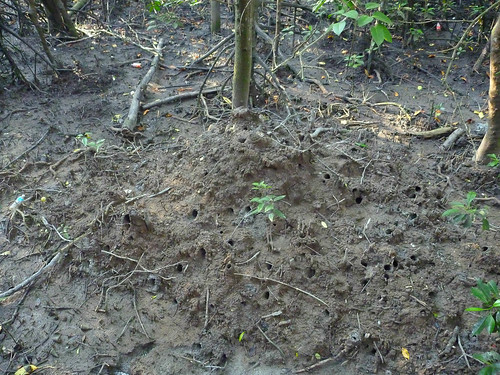
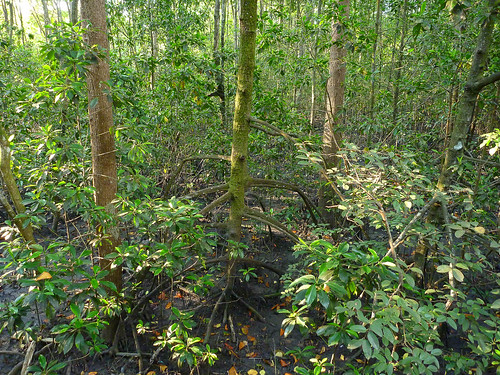
We looked at the bizarre pencil roots of the api-api (Avicennia spp.) and the prop roots of the bakau (Rhizophora spp.). Oi Yee shared how these adaptations enable the trees to survive in such a challenging environment, where the substrate is soft, provides little stability, and has very little oxygen.
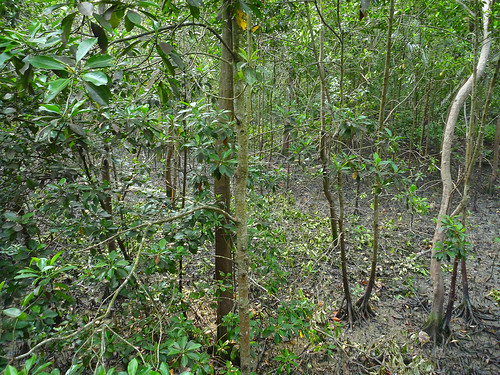
We came across a patch that seemed quite open, with lots of woody debris on the mud. Was this area affected by the strong winds that apparently felled 21 trees in April?
Despite the heat, lots of animals were out and about, probably because evening was approaching and temperatures were starting to dip. My group saw a white-breasted waterhen (Amaurornis phoenicurus), while we heard collared kingfisher (Todiramphus chloris), Oriental magpie robin (Copsychus saularis) and Asian koel (Eudynamys scolopacea). Not to mention the constant buzzing of the cicadas (F. Cicadidae) that were all around us.
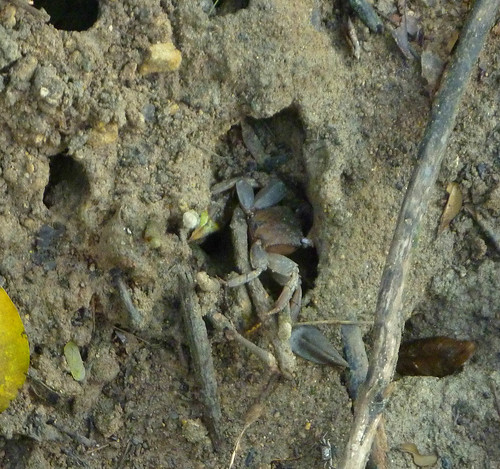
As we walked above the mangrove mud, we stopped to observe the tree-climbing crabs (Episesarma spp.) and rodong (Telescopium telescopium).
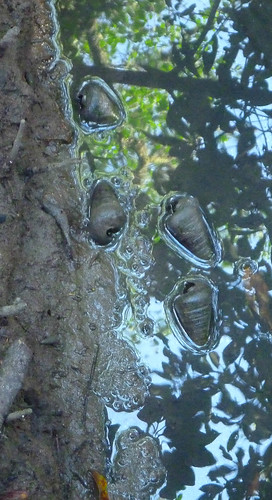
Rodong party in the creeks.

Spot the crabs.
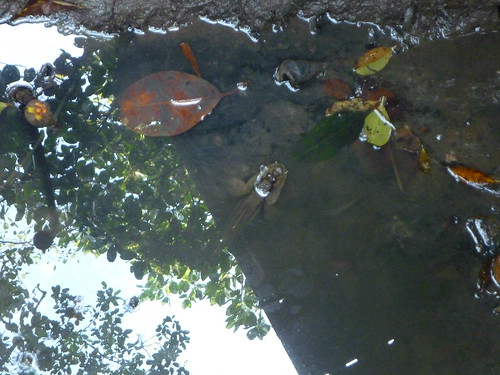
One thing I like about Pasir Ris is that unlike at Chek Jawa, where the mangrove animals can be rather shy, the ones over here seem quite tolerant of human activity, and are readily seen, even by the most casual observer. Along the Chek Jawa boardwalk, it can be difficult to spot the giant mudskippers (Periophthalmodon schlosseri), and the tree-climbing crabs tend to retreat into their burrows when there is a lot of human traffic. On the other hand, here in Pasir Ris, they are so much more easily spotted. For some reason, the tree-climbing crabs and giant mudskippers at Pasir Ris also seem to grow to much larger sizes compared to their counterparts in Chek Jawa.
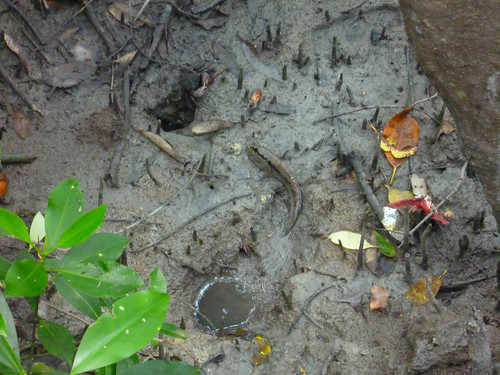
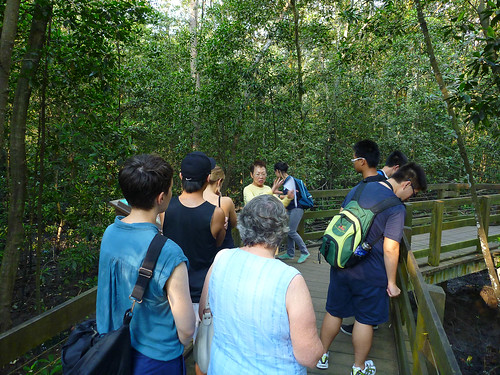
Oi Yee explained how the chut-chut (Cerithidea obtusa) got its name. Another snail I saw was the belongkeng (Ellobium aurismidae).
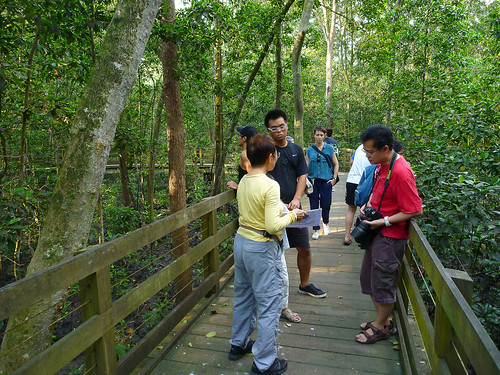
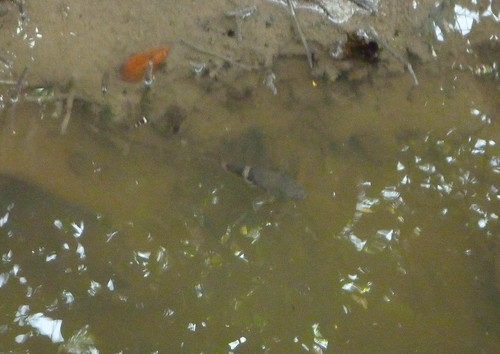
We saw some of these fishes in the water, just before the viewing jetty. Oi Yee and I were unsure of their identity, but after looking up some references, I now know that they are probably snakehead gudgeon (Ophiocara porocephala), a relatively large predatory species that's related to the tiny gobies one normally finds in mangroves and other coastal areas.
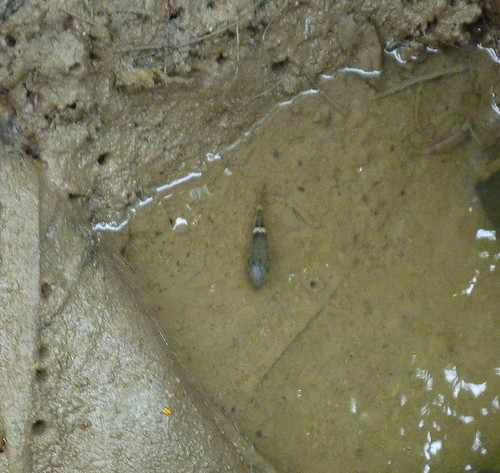
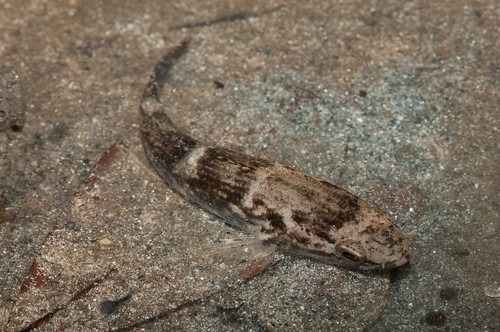
Here's a better photo of a snakehead gudgeon, taken in Malaysia;
(Photo by Steven Wong (ATKR))
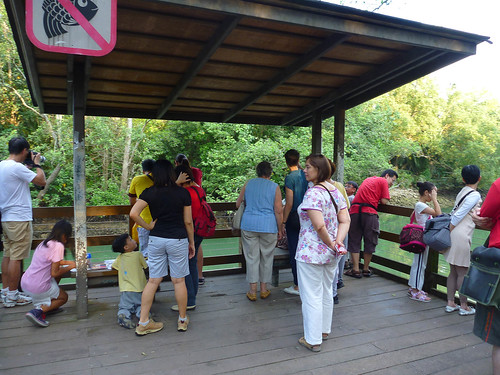
Everyone gathered at the viewing jetty, which was an excellent place to look out for aquatic animals in the river, watch birds, or just admire the peace and serenity of the river.
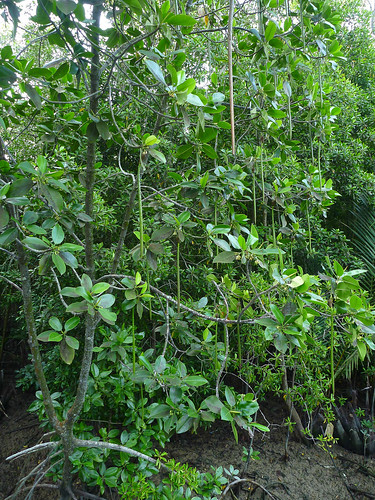
This bakau kurap (Rhizophora mucronata) tree is laden with plenty of propagules, which will eventually fall off and float away. Dr. Dan Friess of NUS has a project that attempts to study the flotation and dispersal capabilities of mangrove propagules; we'll get to learn if there's gene flow between the mangrove forests along our northern coasts, and whether we might receive genetic input from propagules floating from Peninsular Malaysia or even Thailand!
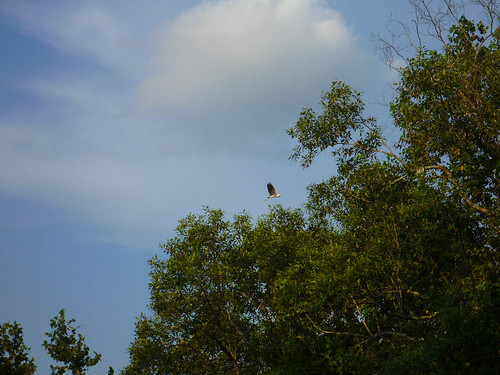
The activities at the nesting colony of grey herons (Ardea cinerea) have died down, although some of the herons are still hanging around.

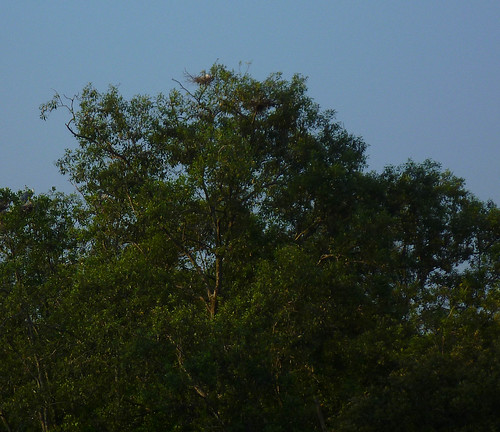
We could still see nests in the crowns of the trees on the opposite banks.
Other birds that I saw from the jetty included several striated heron (Butorides striatus), collared kingfishers, black-naped oriole (Oriolus chinensis), Asian glossy starling (Aplonis panayensis), and parakeets (Psittacula spp.), either native long-tailed parakeets (Psittacula longicauda) or introduced red-breasted parakeets (Psittacula alexandri).
Many of us watched the fishes in the river, and it was obvious that several species were present: shoals of slim, missile-like striped-nose halfbeaks (Zenarchopterus buffonis), needlefish (Strongylura sp.) cruising near the surface like greenish animated javelins, tiny archerfish (Toxotes sp.) with their black and white bands, hanging out near the roots of the mangroves, green chromide (Etroplus suratensis) picking at food on the mangrove roots and river bank, and small schools of grey mullet (F. Mugilidae) lounging about. Every once in a while, an unseen predator would strike from below, sending the halfbeaks leaping out of the water as they attempted to escape their pursuer.
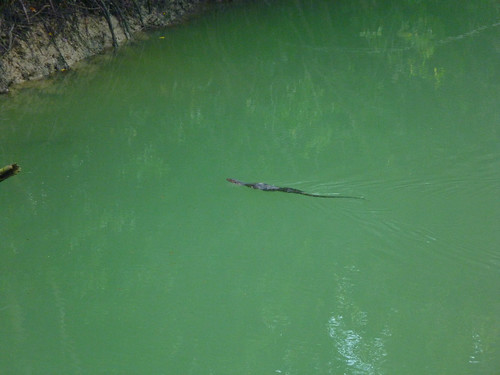
A large Malayan water monitor (Varanus salvator) swam lazily across the river as it searched for food. It got quite close to the jetty.
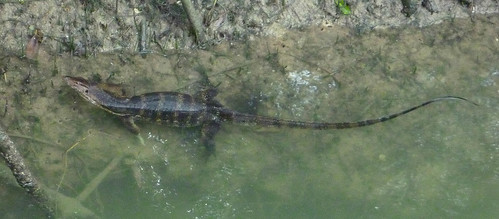
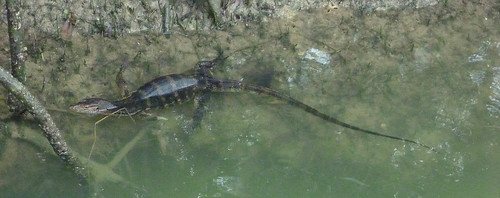
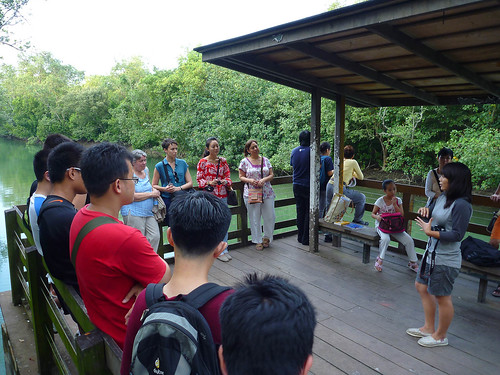
We concluded the guided walk with an interesting activity, a short interactive dialogue with the visitors. Led by Gladys, the original theme was supposed to be "Kids & Conservation in the 21st Century", but with added input from Rick, myself, and some of the more vocal visitors, we ended up talking about a variety of other topics.
Gladys initially talked about how being connected to the Internet provides a window for plenty of opportunities for youths to be exposed to nature and conservation activities, whether it's volunteering for Team Seagrass, or participating in guided walks listed on Wild Happenings in Singapore.
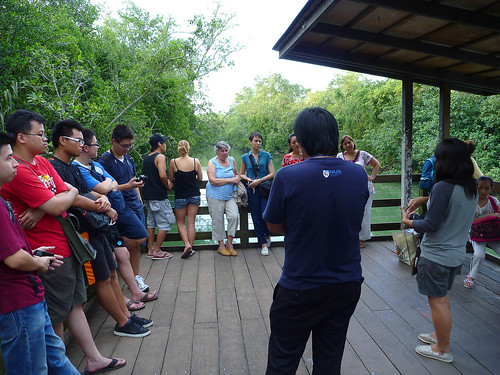
The dialogue then turned towards the pertinent (though often depressing) matter of the threats facing Singapore's mangroves, although I'm sure many of us realised that these same issues can be applied to many other habitats.
Despite their small size, and close proximity to urban development and recreational spaces with high levels of human traffic, the Pasir Ris mangroves are special to many of us, and still harbour a large variety of mangrove plants and animals. One possible problem is whether the mangroves are able to cope with the heavy impact from fellow park users, not all of whom pass through the boardwalk with the aim of appreciating the wildlife and greenery.
During the walk, we had to give way to several people who insisted on cycling on the boardwalk, despite all the signs stating very clearly that cycling was not allowed. At one point during the walk, my group encountered a group of teenagers on bicycles, who were yelling at one another as they raced each other on the boardwalk. And as I shared with the other visitors, we do get people fishing and setting traps for crabs from the viewing jetty.
Perhaps a more insidious threat comes from trash, whether it's washed in from upstream, or by the action of the rain and the tides, or tossed by callous visitors. Oi Yee was saying how the problem of accumulation of plastic litter in the mangroves has improved over the years. Still, dumping of rubbish remains a threat, particularly to the threatened and endangered plants of the mangroves; the last known wild-growing individual on mainland Singapore of a mangrove tree known as pisang-pisang laut (Kandelia candel), located in Pasir Ris, was the hapless victim of a black suitcase last year.
![01iccs-sungei_tampines-17sep2011[nks]](http://farm7.staticflickr.com/6159/6168749786_0146ee904e.jpg)
Volunteers removing trash from Pasir Ris mangroves as part of International Coastal Cleanup Singapore (ICCS);
(Photo by Ng Kai Scene, on habitatnews)
But it may be useful to see the Pasir Ris mangroves in the larger context, as being subject to influences from the surrounding land uses. Just how clean is the sea just off Pasir Ris, and how might this affect the health and growth of the mangroves? Are the mangroves affected by any possible pollution as a result of urban runoff from the residential neighbourhoods further upstream? Monitoring water quality is more than counting bacteria levels and warning people to stay out of the water. Do the fish farms off the coast of Pulau Ubin, Pasir Ris, and Changi have any impacts on the concentrations of pollutants or nutrients in the water? We still don't know what caused the mass fish deaths that occurred in December 2009-January 2011, and on 2 separate occasions in March 2012.
And what about urban development? The Downtown East resort, just across the river from the mangrove boardwalk, is set to undergo a revamp and expansion; how will this possibly impact the mangroves? Even though the crowds and activities within the resort are hidden from view, thanks to the mangrove trees lining the river bank, the noise and loud music do travel. And while the herons don't seem to mind at all, it does raise the question of whether the planned construction works might inadvertently cause some level of disruption.
Elsewhere, near Pasir Ris Park, some parcels of land are likely to be developed in the near future, which will probably lead to the loss of the secondary forests which have been growing there over the years. While the mangroves themselves are probably not directly affected, one does wonder how this might impact the species that can be found in both habitats, such as the white-bellied sea eagle (Haliaeetus leucogaster), red junglefowl, Oriental pied hornbill (Anthracoceros albirostris), long-tailed macaques (Macaca fascicularis), and wild boar (Sus scrofa vittatus). What's the possibility of us facing a scenario in which the wildlife starts moving into Pasir Ris Park, or even into the residential neighbourhoods, once the development of these areas begins?
White-bellied sea eagles, Pasir Ris;
The forest where these eagles are nesting has been earmarked for development.
(Video by Andy)
Which leads to a final issue, that of human-wildlife conflict. Most of the time, the wildlife of the mangroves is seen as benign and non-threatening. Still, there will be some who may view the smooth otters (Lutrogale perspicillata) and Malayan water monitors as being dangerous to people. Wild boar and macaques, which can behave aggressively towards people, and which have the potential to be seen as a nuisance, are probably transients and are currently not long-term residents of this patch of mangroves.
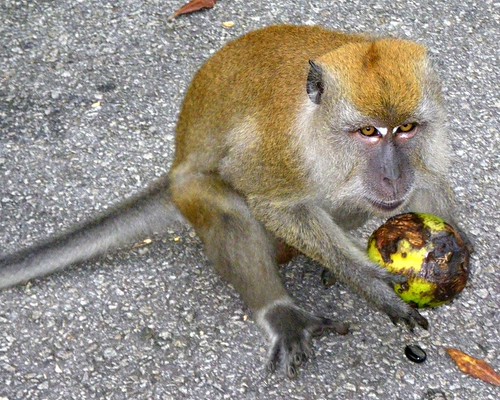
Long-tailed macaque, Pasir Ris Park (August 2009);
(Photo by Kok Sheng)
But what about estuarine crocodiles (Crocodylus porosus)? Crocodiles (albeit small ones) have been seen in Pasir Ris from time to time, with the last encounter occurring in August 2008. Unlike Sungei Buloh, which is not located close to urban development or recreational beaches, it can be argued that allowing crocodiles to persist in Pasir Ris would pose a grave threat to people. Still, it does beg the question of whether there are ways in which we can allow crocodiles to make a return to the mangroves of Pasir Ris, while at the same time mitigating the risks to human safety through education and legislation, ensuring that human behaviour is managed appropriately.
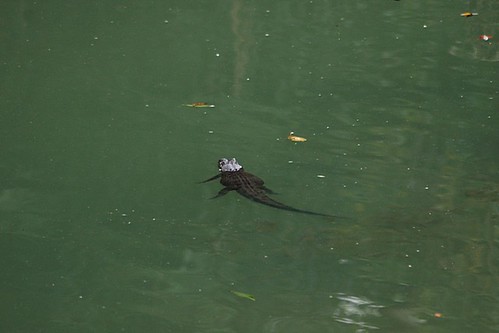
Juvenile crocodile, Pasir Ris Park (August 2008);
(Photo by wingsaf)
I also raised the point of the importance of public feedback, that we need more people to show their appreciation for our biodiversity, and to fight for the conservation and protection of our green spaces and wildlife. Compared to the situation a couple of decades back, the government is making efforts to show that it is receptive and willing to listen to the views of the public, and there are some notable examples illustrating how this has worked in favour of conserving green spaces, even if concessions and compromises have to be made.
Conservation should not be limited to so-called "greenies" or "tree-huggers", it should be something practised by the general populace. After all, given our space constraints, and the national mantra that we are always in a precarious position and need to be innovative and competitive to ensure our survival, perhaps we really ought to be mindful of how much we rely on nature and natural processes for goods and services, and the need to live in a manner which does not impose too much pressure on our surrounding environment.
It can be difficult or even impossible to put a price on the value of setting land aside for conservation, and sacrificing whatever economic benefits can be reaped from developing that same piece of land for residential, commercial, or industrial purposes. But I'm sure that many, even laymen who don't necessarily label themselves as environmentalists, would agree in the importance of the intangible, things that we cannot calculate in terms of dollars and cents. Ideas like biophilia, natural capital, and natural heritage are often used in discussions regarding conservation, and while we may not have vast expanses of wilderness, perhaps Singapore might do well to place more emphasis on reconnecting people and nature. Can we truly call ourselves a Garden City if we have lots of flowers and trees, yet the citizens don't truly understand that we function within a larger network of ecological processes?
Like I said, heavy stuff, and not quite in keeping with the initial plan to focus on having youths involved in conservation. Oops.
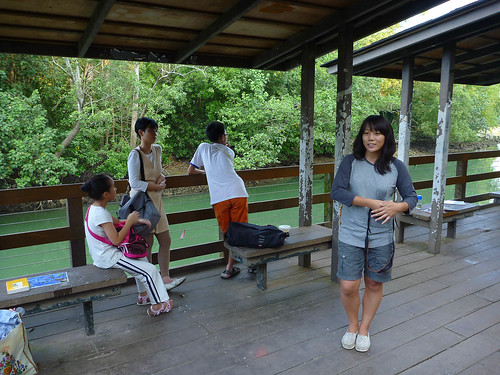
Gladys was nervous (it being her first time in the spotlight), and I think the discussion could have been more focused, while keeping the whole gloom and doom aspect to a minimum. Still, I hope the visitors who took the time to listen to us and share their own views have learnt something valuable, and can hopefully help to share the idea of conservation with their families and friends. It's the whole reason why we hold these guided walks in the first place, to help people open their eyes to the wildlife and ecosystems that surround us, and to adopt habits that will help build a community that is more sensitive and accepting of the need to conserve our natural heritage.

Dusk brought relief from the heat of the afternoon sun.
Fresh from the disappointment of Rio+20, with the world's leaders failing to present a strong united stand in working towards mitigating and reducing the impacts that humans are having on the environment, it's easy to feel a sense of anger, despair, and helplessness.
Still, we do what we can. Nobody knows the ultimate outcome of this struggle; we may win some battles, but lose others. Or humanity might just end up wiping itself out, along with a great chunk of the Earth's biodiversity. One thing's for sure: even as we try our best as individuals to win hearts and minds, to help instill values and knowledge that will foster a deep-seated appreciation for nature and a desire to protect it, it always warms the heart to know that we are not alone.